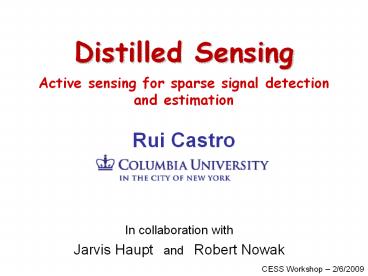Distilled Sensing Active sensing for sparse signal detection and estimation - PowerPoint PPT Presentation
Title:
Distilled Sensing Active sensing for sparse signal detection and estimation
Description:
Distilled Sensing. Active sensing for sparse signal detection and ... Proceeding in this fashion we gradually focus on the signal... Main ... 1 - Sketch ... – PowerPoint PPT presentation
Number of Views:49
Avg rating:3.0/5.0
Title: Distilled Sensing Active sensing for sparse signal detection and estimation
1
Distilled Sensing Active sensing for sparse
signal detection and estimation
- Rui Castro
In collaboration with Jarvis Haupt and Robert
Nowak
CESS Workshop 2/6/2009
2
A Sparse Signal Model
Sparse signal models are extremely useful is a
variety of applications (e.g., image
reconstruction, compression, etc.)
signal support set
Example
In this talk we will assume .
3
Detection/Estimation of Sparse Signals
fMRI data
Astronomical data
Microarray data
Two fundamental questions
Can we efficiently detect sparse signals?
Can we locate sparse signals efficiently?
In this talk I will focus on the second question.
4
A Sparse Signal Model
Observation model
Intuitively signal components correspond to the
largest observations
Because of noise
even if no signal is present
How small can ? be so that we can still reliably
locate the signal components from the
observations?
5
A Sparse Signal Model
When testing a large number of hypotheses
simultaneously we are bound to make errors!!!
Approaches
Control the probability of perfect localization
of the support (Bonferroni correction) very
conservative
Control the relative proportion of errors
(Benjamini Hochberg 95)
6
False Discovery Rate Control
Recall the definition of the signal support set
Goal Estimate the support as well as possible.
Let
be the outcome of a support estimation procedure.
False Discovery Proportion
falsely discovered components
discovered components
Non Discovery Proportion
missed components
true components
Since n is typically very large it makes sense to
study asymptotic performance, as n! 1 .
7
Known Results (Jin Donoho 03)
Assume the signal is very sparse
Number of signal components
n 10000 ) Is10
Example? 3/4
n 1000000 ) Is32
8
Known Results (Jin Donoho 03)
Signal strength
Estimable
Non-estimable
Sparsity
These asymptotic results tell us how strong the
signals need to be for reliable signal
localization
9
A Generalization of the Sensing Model
Allow multiple observations
subject to a sampling energy budget
are called the sensing vectors.
(Note in the previous work a single observation
was considered, where
)
10
Active Sensing
sensing vector
signal
observation
Key Idea allow future sensing vectors to depend
on past observations
Dependence on previous observations allows us to
focus the sampling energy in promising regions!!!
11
A Simple Focusing Procedure
Proceeding in this fashion we gradually focus on
the signal
12
Main Result Part 1
Theorem 1 (J. Haupt, RC and R. Nowak)
Furthermore if one does not allow an active
sensing scheme then the previous results
(equivalent to k0) cannot be improved.
The improvement is due to the use of feedback,
not the fact that we have multiple measurements!!!
13
Localization Thresholds
Best passive sensing performance
Signal strength
Sparsity
These results suggest we might be able to
estimate signal with amplitudes growing slower
than
14
Distilled Sensing Example
original signal (0.8 non-zero components)
Noisy version of the image (k0)
Noisy versions of the image (k5)
Active sensing recovery (FDR 0.01)
Passive sensing recovery (FDR 0.01)
15
Main Result Part 2
Theorem 2 (J. Haupt, RC and R. Nowak)
The use of sampling feedback greatly decreases
the signal strength needed for reliable
localization!!!
16
Now you see it, now you dont
sparse signal
noise
Weak signals/patterns are imperceptible without
active sensing!!!
17
Final Remarks
Sampling strategy
Closing the loop can yield dramatic gains
allowing us to even perceive signals that were
otherwise imperceptible!!!
rmcastro_at_ee.columbia.edu http//www.ee.columbi
a.edu/rmcastro
18
Extensions
The same ideas can be used to signal detection as
well
Signal strength
Sparsity
19
Proof of Theorem 1 - Sketch
With high probability each distillation keeps
almost and the signal components and rejects
about half non-signal components
20
Proof of Theorem 1 - Sketch
This implies that the final measurement of
distilled sensing is essentially equivalent to
the one-observation model where
Using BH thresholding on the above signal yields
the final result (from Donoho and Jin 03)
21
Distilled Sensing (DS)
Input
Initialize
while
Output

